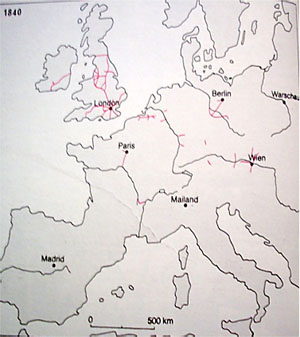2. “The Railway Network in Europe in 1840 and 1880”
Questions
Geographical/Historical Context
In England, the expansion of the railway at the beginning of the 19th century can be observed especially in the coastal regions. By train, the goods were transported to the ports in order to be shipped worldwide from there; this was true for produced goods as well as for raw material needed for the production of the former. On the mainland, the development was similar. The cities connected to the rail network were mostly situated close to rivers, so that here, too, the connection facilitated mainly the transportation of goods.
Only at the end of the 19th century, was Europe fully developed, though even then, some areas were better developed while others were at the beginning of their development (e.g. the Alpine region, large regions of Spain). In the latter areas, the external circumstances impeded significantly the development; in the Alpine region, for example, mountains had to be surmounted.
Answer to the Questions
1:
- 1840: Clear lead of England in the development of the railway network; industrialization began in England and spread to Europe only in the course of the 19th century.
- Some large cities (Paris, Berlin, Vienna) already had a connection to the rail routes in 1840, yet no fully developed network existed back then in Europe; in case of some cities, they developed rail connections only to the nearest bigger river.
- In the course of the industrialization, smaller towns were also connected to the railway network.
2:
- Centres: Production of pig iron and coal production.
- Short ways of transport to the processing sites.






Presentation
The maps show the swift development of the railway network in Europe. In 1840, while only some big cities were connected on the continent, England already showed a clear lead.